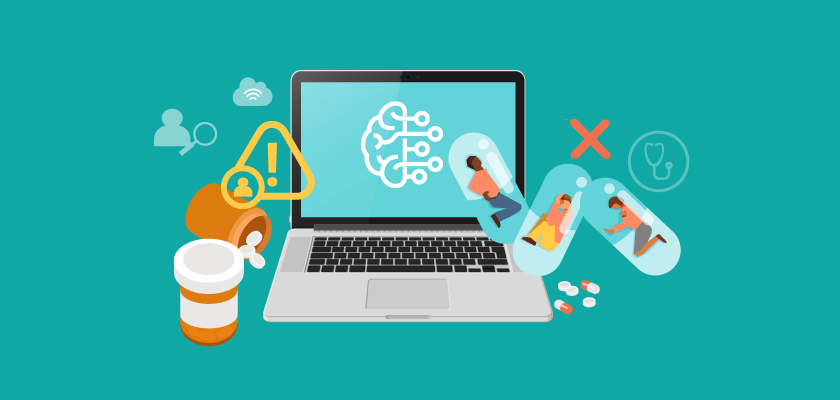Facing the Opioid Crisis by Identifying Signs of Drug Diversion

The opioid crisis is an ongoing dilemma in the healthcare industry. In the past year alone, more than 115 people died each day from prescription opioid overdoses in the United States. And hospitals are breeding grounds for opioid diversion amongst healthcare workers – in-house pharmacies are stocked full of controlled substances that are easy to access – and it only takes one or two doses to become addicted. When privacy and security professionals are tasked with the challenge of identifying signs of drug diversion, where do you start?
Dangers of drug diversion
Drug diversion occurs any time a prescription medication is removed or deviated from its intended path between a manufacturer and patient. Hospitals and other medical centers have access to in-house pharmacies and as an unfortunate consequence, 15% of healthcare workers struggle with drug addiction as opposed to 8% of the general population.
“When you are working in a healthcare facility every day, you have access to medications. It’s easy to become addicted.” – Kara Earle, Drug Diversion Specialist at Imprivata FairWarning
For the most part, people aren’t diverting drugs with malicious intent – instead, they struggle with addiction.
“There are very few instances where drug diversion is made for financial gain. In the vast majority of cases, it’s addicts feeding their own addiction.” – Commander John Burke, President of Pharmaceutical Diversion Education
Although hospitals are required by law to investigate, report, and remediate all instances of drug dispensing that doesn’t match the quantity administered to patients, fewer than 5% of these cases end up being investigated. And even without nefarious intent, the dangers associated with drug diversion are numerous, including:
- Denial of pain relief for patients
- Fraud and identity theft
- Exposure to bloodborne pathogens
- Regulatory liability and fines
- Reputational damage to healthcare organizations
At a hospital in Washington, 13 patients were infected with the hepatitis C virus, the cause of which was traced to a nurse who confessed to diverting narcotics for her own use before treating patients with the same needle.
Health organizations must mitigate drug diversion to avoid its dire consequences. Unfortunately, drug diversion is often overlooked, making it an even larger problem. Why hasn’t this crisis been fully addressed at US healthcare facilities? It’s likely due to the NIMBY effect.
Not-in-my-backyard
A 2019 survey conducted by KRS Research for Becton, Dickinson and Co. (BD) has found that although nearly 85% of healthcare leaders agree that drug diversion is a pressing concern in medical centers across the United States, only 20% believe that it exists within their own organizations.
A key discovery in this study is the “Not-In-My-Backyard (NIMBY) Effect,” or the belief that drug diversion is somebody else’s problem – even though half of the healthcare professionals surveyed reported observing suspicious activity that could be evidence of diversion.
“Healthcare executives and providers recognize this is a problem but not at their institution. So with that, it’s difficult to become resourced appropriately to do diversion management or any kind of management with controlled substances.” – Katelyn Hipwell, Pharm.D., M.P.H., Pharmacy Clinical Operations Manager for the University of Virginia Health System
Another detail of note found in the survey is that 54% of healthcare executives stated that technological innovations such as artificial intelligence (AI) would help them to address the problem. So how can AI help identify and eradicate cases of drug diversion?
Where AI comes into play
AI and machine learning can help identify cases of drug diversion. Machine learning is a component of AI that ingests massive amounts of information and uses it to identify patterns. Consequently, when fed EHR data, the machine analyzes behavioral deviations that can identify a staff member who might be at risk for opioid addiction.
The good news is that the use of AI use in healthcare organizations is on the rise – according to an Intel survey, 37% of participants already use AI while 54% expect to see a widespread adoption of AI for clinical, operational, and financial use within the next five years.
Using AI to identify those at risk for opioid use and drug diversion can empower staff to seek help for employees who struggle with addiction, in turn saving lives.
Tackling the opioid crisis at medical organizations
In addition to adopting AI, there are additional ways to face the opioid epidemic at healthcare facilities –one key way to accomplish this is by establishing a drug diversion monitoring program. The key steps to creating a comprehensive program include:
- Obtaining executive support and HR buy-in
- Forming a drug diversion committee
- Training staff to identify addicts and drug diverters
- Creating anonymous reporting capability for staff
- Hiring and empowering drug diversion specialists
- Proactively monitoring for drug diversion
- Proper reporting to the DEA and law enforcement
- Providing rehabilitation for addicts
- Incorporating findings back into training and proactive monitoring programs
Implementing anonymous reporting capability for staff and rehabilitation options for addicts is vital, as medical staff is incentivized to report drug diverters – who may be colleagues, friends, or family members– without creating repercussions to themselves. This also provides diverters with a mechanism to receive the help they need. This protects those who report diversion, patients, organizational reputation, and the diverters themselves.
The impact of drug diversion on the healthcare industry can’t be ignored. Fortunately, there are ways of detecting and rehabilitating those affected. By creating a drug diversion monitoring program and using the technical advantages AI has to offer, you can keep your patients – and diverters– safe from the harmful effects of the opioid crisis in healthcare organizations.
